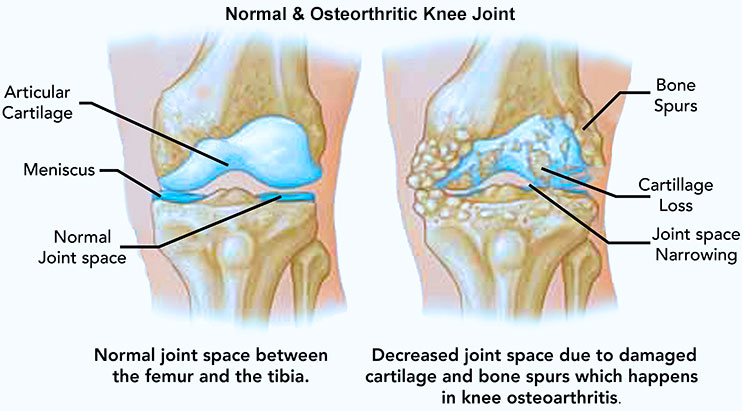


Your knee is a hinge joint where the end of the thigh bone (femur) meets the beginning of the large bone in your lower leg (tibia). A healthy knee has smooth cartilage that covers the ends of the femur and tibia. The smooth cartilage lets the surfaces of the two bones glide smoothly as you bend your knee. The muscles and ligaments around the knee joint support your weight and help move the joint smoothly so you can walk without pain.
The smooth cartilage layers can wear down on the ends of the femur and tibia. When the smooth surfaces become rough, the surfaces are like sandpaper. Instead of the joint gliding when you move your leg, the bones grind and you have pain and / or stiffness.
This degeneration can happen due to variety of reasons such as the following:
When pain in your knee or leg prevents you from doing your usual activities and your x-rays show irregular surfaces at the knee, your doctor might suggest that you have a knee replacement.
A Total Knee Replacement (TKR) or Total Knee Arthroplasty is a surgery that replaces the worn or damaged parts of your knee joint with artificial metal or plastic replacement parts called the 'prostheses'. The procedure is usually recommended for older patients who suffer from pain and loss of function from arthritis and have failed results from other conservative methods of therapy.
To create a new knee joint, the ends of the bones forming the joint are surgically removed. They are replaced with parts like the pieces shown in the following video animation. The parts of the prosthesis are made of metal and very strong plastic. The pieces may be cemented in place with a special bone cement, or the metal may have a porous surface that bone will grow into to create a tight fit.
The following video animation displays how the new TKR prosthesis replaces your degenarated knee joint.
Your orthopaedic surgeon, Dr. (Prof.) Anil Arora, will encourage you to use your new joint as soon as possible after your operation. Patients often stand and begin walking the day of or the day after surgery. Physio therapy (PT) will begin in the afternoon of surgery or the day after.
Based on the surgery performed and what happens during your surgery, Dr. Arora will decide after surgery how much weight you can put on your surgical leg. This is called your Weight Bearing Status (WB Status). This may change throughout your hospital stay and your recovery from joint replacement surgery.
You will walk with a walker, then crutches or cane at first as you recover. Most patients have some temporary pain after joint replacement as the tissues heal and muscles regain strength. This pain should go away in a few weeks or months. Pain medication will be ordered for you and your pain level will be monitored. Your health care team will make every effort to keep you comfortable.
Regaining strength and motion after knee replacement surgery is dependent on you. Once you get back home and follow the exercises prescribe by your physio team you should be able to get most of your strength and mobility back.
With your new knee replacement and the help of your orthopaedic team, you may be able to resume most of the activities you once enjoyed. You may be permitted to go on long walks, dance, play golf, garden and even ride a bicycle.
Total Knee Replacement (TKR) has an excellent track record for improving quality of life, allowing greater independence and reducing pain.